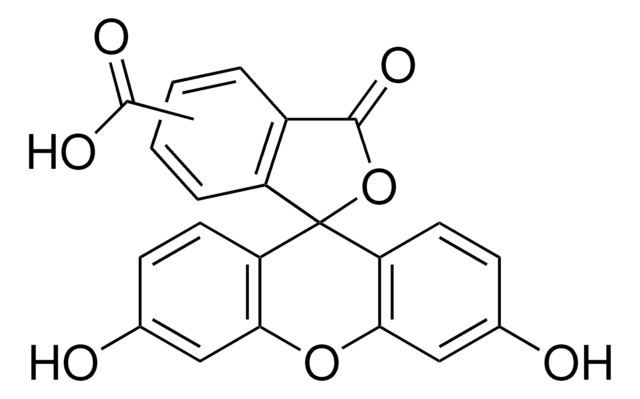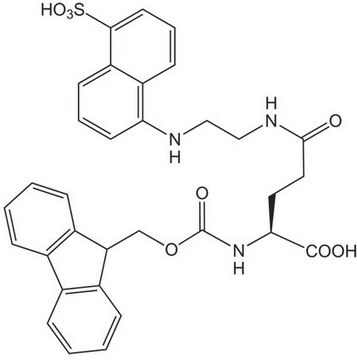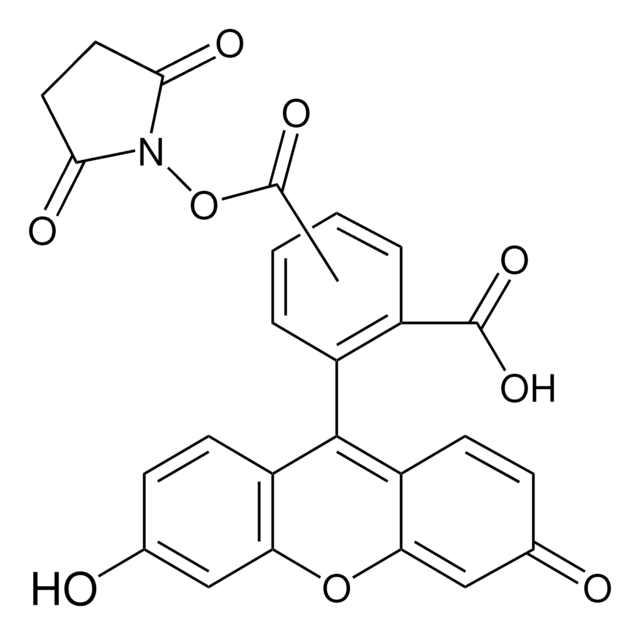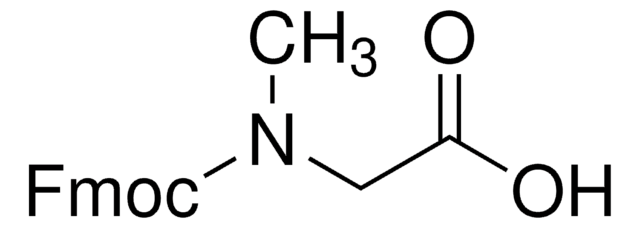94822
Abberior® CAGE 552, NHS ester
for single-molecule switching microscopy (e.g. PALM, STORM, GSDIM)
Faça loginpara ver os preços organizacionais e de contrato
About This Item
Fórmula empírica (Notação de Hill):
C30H25N5O6
Peso molecular:
551.55
Código UNSPSC:
12352200
NACRES:
NA.32
Produtos recomendados
Ensaio
≥80.0% (degree of coupling)
solubilidade
DMF: 0.25 mg/mL, clear
fluorescência
λex 552 nm; λem 584 nm±10 nm in PBS, pH 7
temperatura de armazenamento
−20°C
Descrição geral
Absorption Maximum, λmax: 231, 308, 350 nm (non-activated, PBS, pH 7.4)
552 nm (photoactivated, PBS, pH 7.4)
Extinction Coefficient, ε(λmax): 66,000 M-1cm-1 (photoactivated, PBS, pH 7.4)
Fluorescence Maximum, λfl: 574 nm (photoactivated, PBS, pH 7.4)
Photoactivation Wavelength:360 - 440 nm
Recommended STED Wavelength, λSTED: 650 − 670 nm
Fluorescence Quantum Yield, η: 0.37 (after photoactivation, PBS, pH 7.47)
552 nm (photoactivated, PBS, pH 7.4)
Extinction Coefficient, ε(λmax): 66,000 M-1cm-1 (photoactivated, PBS, pH 7.4)
Fluorescence Maximum, λfl: 574 nm (photoactivated, PBS, pH 7.4)
Photoactivation Wavelength:360 - 440 nm
Recommended STED Wavelength, λSTED: 650 − 670 nm
Fluorescence Quantum Yield, η: 0.37 (after photoactivation, PBS, pH 7.47)
Aplicação
- Abberior® CAGE 552 has been conjugated with secondary anti-guinea pig antibody for PALM (photo-activated light microscopy) imaging in MDA-MB-468 and COS-7 cells.
- It has been labelled with secondary antibody to perform dSTORM (direct stochastical optical reconstruction microscopy) for localization of deposited callose in destained Arabidopsis thaliana leaves.
- Abberior® CAGE 552 goat anti-mouse antibody has been used for FPALM (fluorescence photoactivation localization microscopy) imaging in NIH-3T3 fixed cells.
- It has been used for PALM imaging of silica colloids.
- It has also been used for PALM imaging of functionally asymmetric GPCR (G protein-coupled receptor) oligomers.
Adequação
Designed and tested for fluorescent super-resolution microscopy
Outras notas
Informações legais
abberior is a registered trademark of Abberior GmbH
Código de classe de armazenamento
11 - Combustible Solids
Classe de risco de água (WGK)
WGK 3
Ponto de fulgor (°F)
Not applicable
Ponto de fulgor (°C)
Not applicable
Escolha uma das versões mais recentes:
Já possui este produto?
Encontre a documentação dos produtos que você adquiriu recentemente na biblioteca de documentos.
Antonio Aloi et al.
Journal of the American Chemical Society, 138(9), 2953-2956 (2016-02-18)
The introduction of super-resolution fluorescence microscopy (SRM) opened an unprecedented vista into nanoscopic length scales, unveiling a new degree of complexity in biological systems in aqueous environments. Regrettably, supramolecular chemistry and material science benefited far less from these recent developments.
Kim C Jonas et al.
The Journal of biological chemistry, 290(7), 3875-3892 (2014-12-18)
Formation of G protein-coupled receptors (GPCRs) into dimers and higher order oligomers represents a key mechanism in pleiotropic signaling, yet how individual protomers function within oligomers remains poorly understood. We present a super-resolution imaging approach, resolving single GPCR molecules to
Steven J Tobin et al.
PloS one, 9(2), e87225-e87225 (2014-02-08)
Ethanol affects the signaling of several important neurotransmitter and neuromodulator systems in the CNS. It has been recently proposed that ethanol alters the dynamic lateral organization of proteins and lipids in the plasma membrane, thereby affecting surface receptor-mediated cellular signaling.
Michael J Mlodzianoski et al.
PloS one, 11(3), e0147506-e0147506 (2016-03-24)
Localization microscopy can image nanoscale cellular details. To address biological questions, the ability to distinguish multiple molecular species simultaneously is invaluable. Here, we present a new version of fluorescence photoactivation localization microscopy (FPALM) which detects the emission spectrum of each
Dennis Eggert et al.
Scientific reports, 4, 4159-4159 (2014-02-25)
Successful defence of plants against colonisation by fungal pathogens depends on the ability to prevent initial penetration of the plant cell wall. Here we report that the pathogen-induced (1,3)-β-glucan cell wall polymer callose, which is deposited at sites of attempted
Nossa equipe de cientistas tem experiência em todas as áreas de pesquisa, incluindo Life Sciences, ciência de materiais, síntese química, cromatografia, química analítica e muitas outras.
Entre em contato com a assistência técnica






